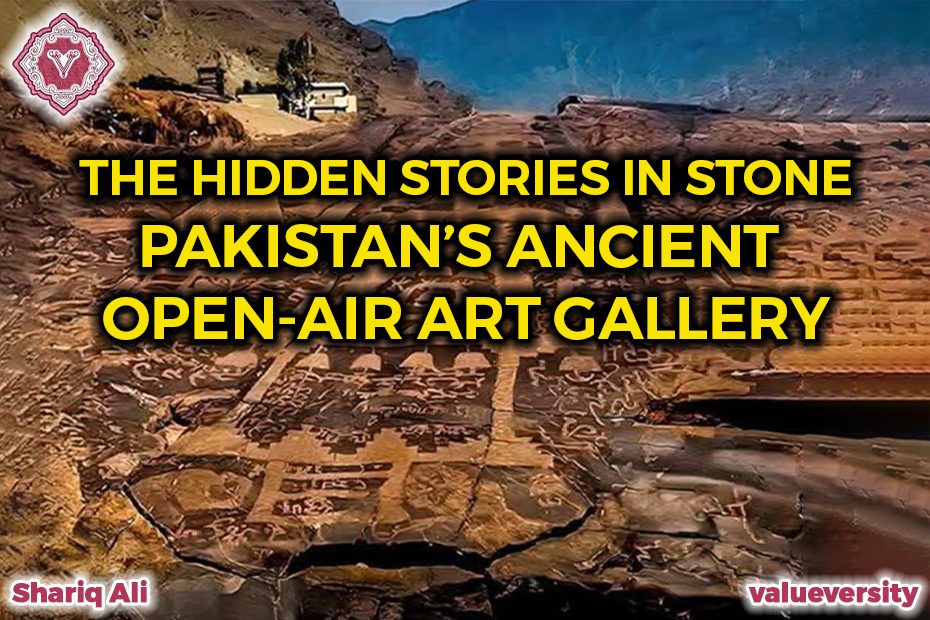The Hidden Stories in Stone: Pakistan’s Ancient Open-Air Art Gallery
Researched & Compiled by:
Shariq Ali
Valueversity
A Journey Through Time on the Ancient Silk Road
Imagine yourself traveling on a winding mountain road, surrounded by towering peaks, as your vehicle moves along an ancient path. Now, pay close attention—on the roadside, you spot large boulders etched with human-made carvings. These are not just random marks; they are stories left behind by ancient caravans, hunters, monks, and travelers thousands of years ago.
Between Shatial and Raikot Bridge on Pakistan’s Karakoram Highway, a 100-kilometer-long stretch holds one of the world’s largest open-air art galleries. This region is home to over 50,000 petroglyphs (rock carvings) and 5,000 inscriptions, spanning from the 9th century BCE to the 16th century CE. These carvings offer invaluable insights into ancient lifestyles, religious beliefs, artistic expressions, and historical transitions.
What Are These Rock Carvings?
These carvings, known as petroglyphs, were engraved onto stone surfaces using sharp tools or pointed rocks. The themes depicted in these carvings vary across different historical periods:
- Early Period Carvings (9th Century BCE – 1st Century CE)
These are the oldest carvings, primarily depicting hunting scenes. They showcase hunters wielding bows and arrows, chasing wild ibex (mountain goats). The human figures are mostly triangular, reflecting the simple social structures of that time.
- Buddhist Influence (1st Century CE – 8th Century CE)
During this period, Buddhism spread along the Silk Road, connecting India, China, and Central Asia. Buddhist monks began engraving sacred symbols on these rocks.
Common motifs from this era include:
Stupas (Buddhist shrines)
Lotus flowers (symbols of spiritual purity)
Jataka tales (stories of Buddha’s past lives)
- Arrival of Warriors and Riders (8th Century CE – 16th Century CE)
Carvings from this period depict horse-riding warriors, soldiers with weapons, and battle scenes, reflecting the social and political transformations in the region.
Additionally, many inscriptions in ancient scripts are found alongside these carvings, serving as historical evidence of diverse civilizations passing through this land.
Why Is This Region Important?
This area was a key trade route on the Silk Road, connecting China, India, Persia, and the Roman Empire. For centuries, traders, pilgrims, and travelers passed through here, leaving behind written inscriptions in multiple languages, including:
Kharosthi & Brahmi (ancient South Asian scripts)
Sogdian (Central Asian language)
Chinese & Tibetan
Proto-Sharada (ancient North Indian script)
Ancient Hebrew (indicating the presence of Jewish travelers)
This proves that the region was a cultural and commercial melting pot, facilitating exchanges between civilizations.
Are These Rock Carvings in Danger?
Unfortunately, the construction of the Diamer-Bhasha Dam poses a serious threat. Once completed, the rising water levels will submerge this entire area, potentially erasing these ancient treasures forever.
Archaeologists and historians are racing against time to document, relocate, or digitally record these carvings to ensure their preservation for future generations.
Why Should We Care About This Cultural Heritage?
Remember, these carvings are not just rocks—they are history books etched in stone. They tell us who lived here, what they believed in, and how they saw the world. If we lose them, we lose an irreplaceable part of our past.
By raising awareness, we can push for conservation efforts to protect these invaluable artifacts. Understanding our past helps us see the present more clearly and build a better future.
Final Thought: Silent Stones That Speak
The petroglyphs between Shatial and Raikot Bridge are a priceless historical treasure for Pakistan and the world. These silent stones have endured thousands of years, yet they continue to tell their stories—we just need to listen.
Will we allow them to be lost forever, or will we take action to preserve them?
Next time you travel on the Silk Road, take a moment to look at the surrounding rocks—you might just hear a story that’s thousands of years old!
